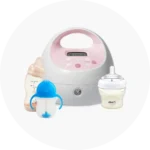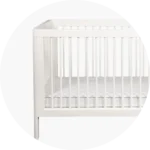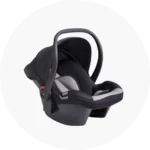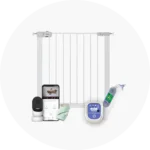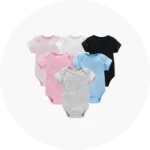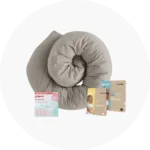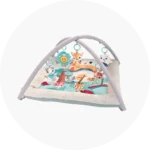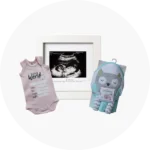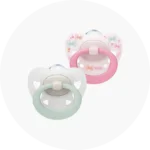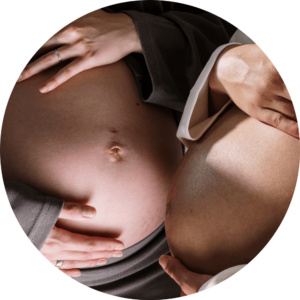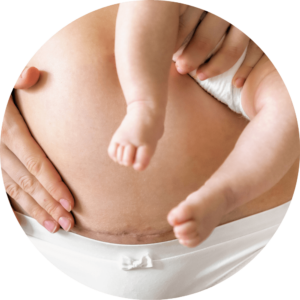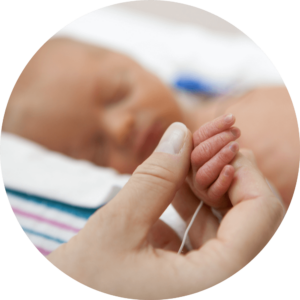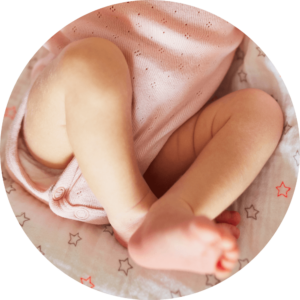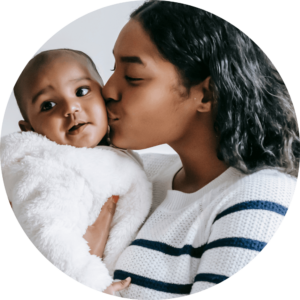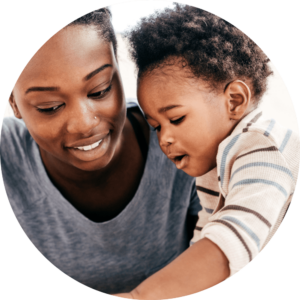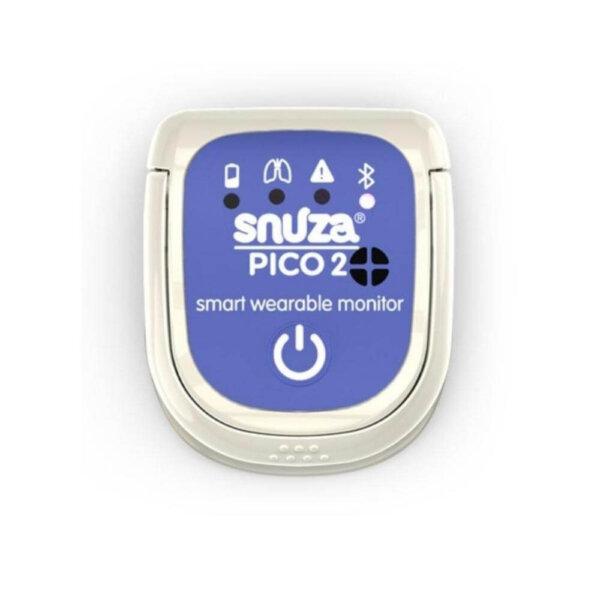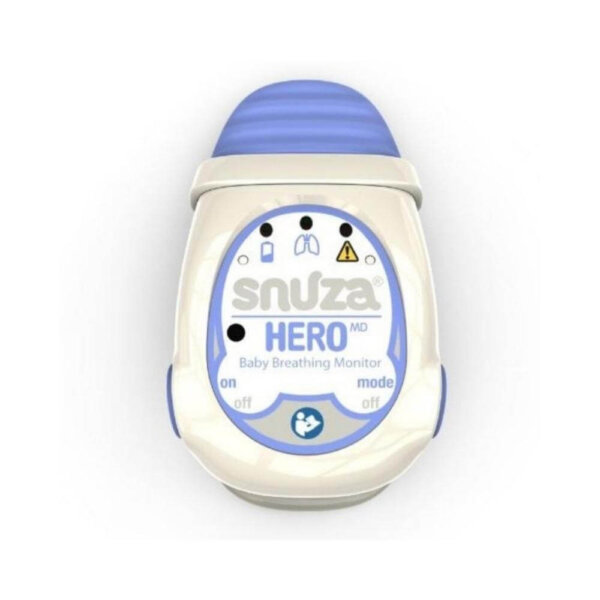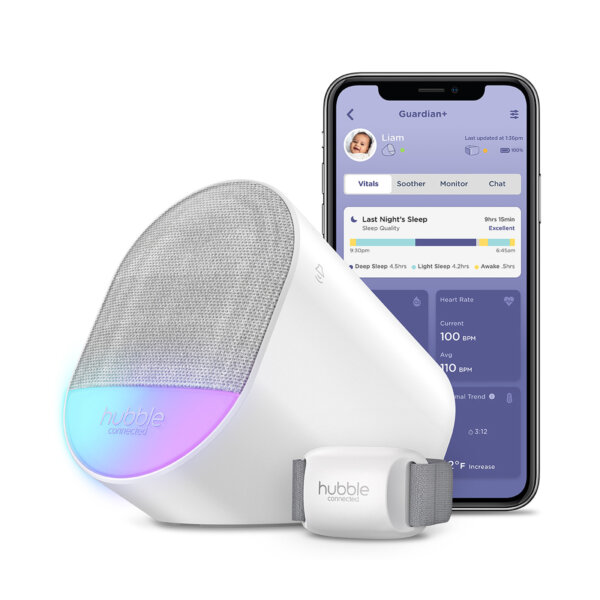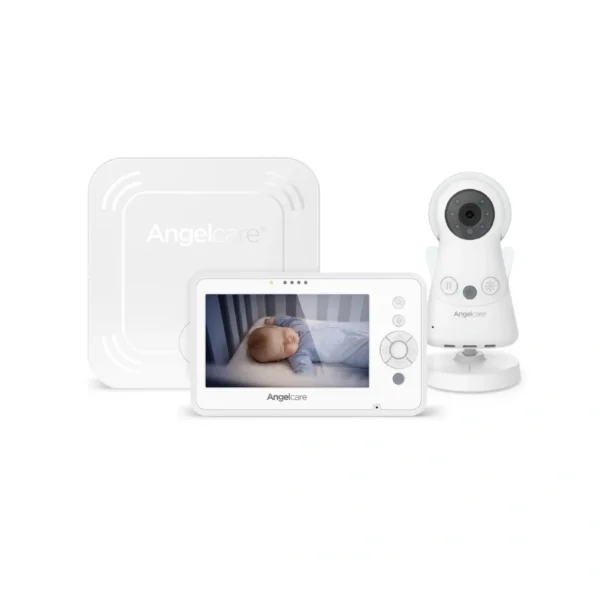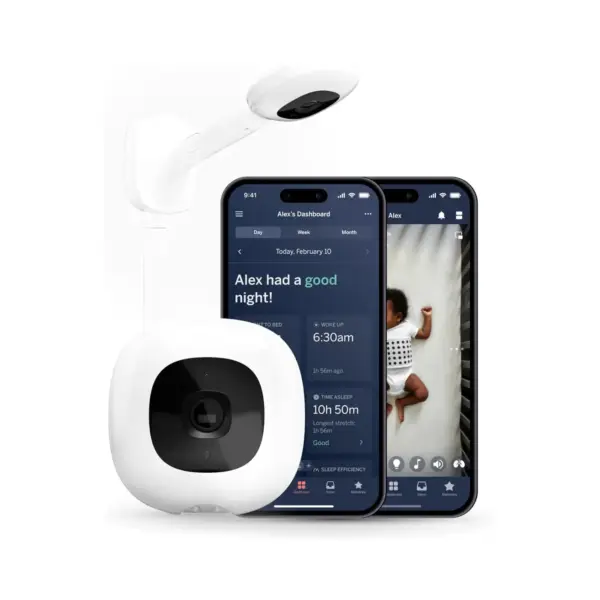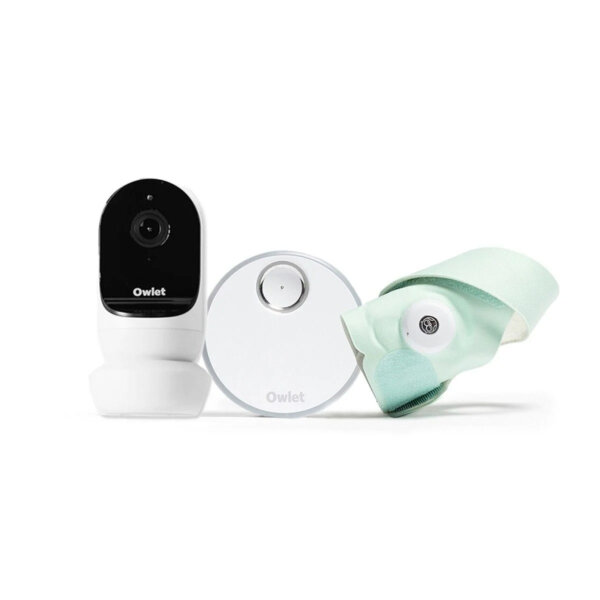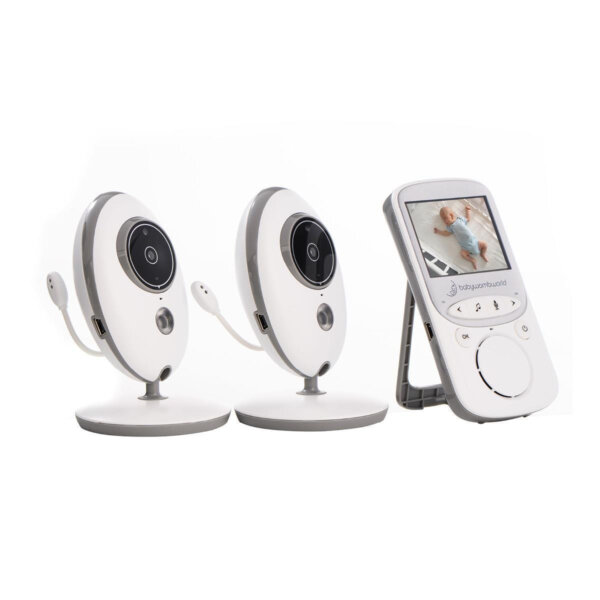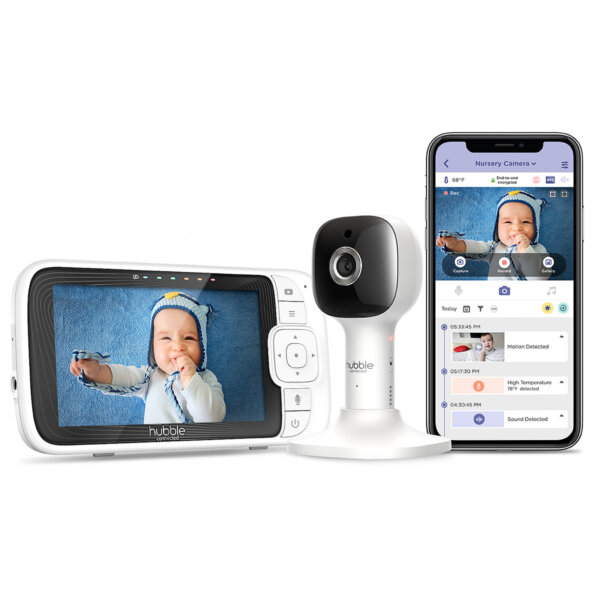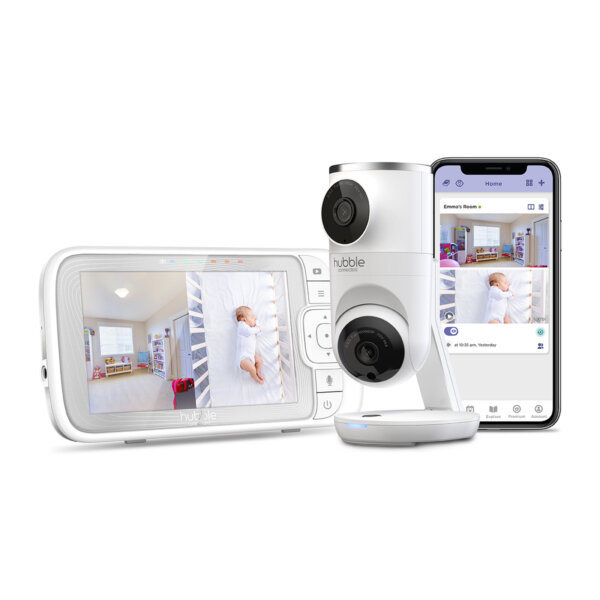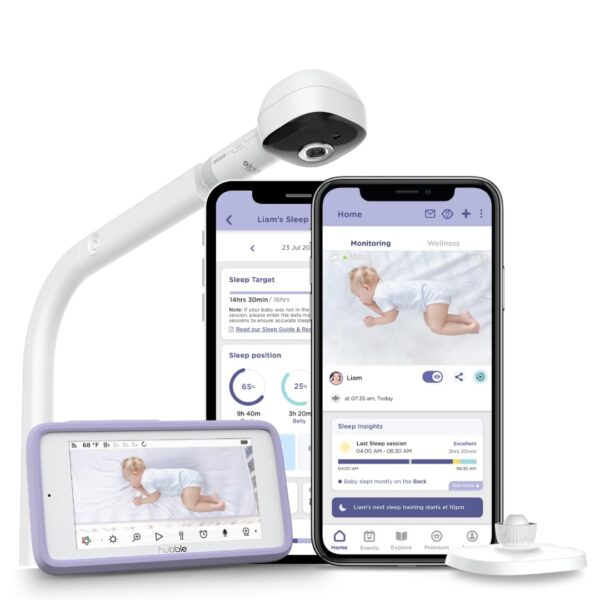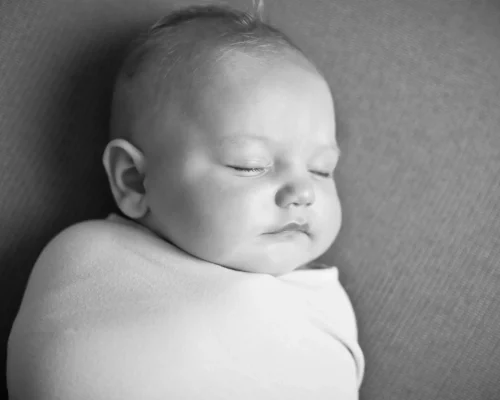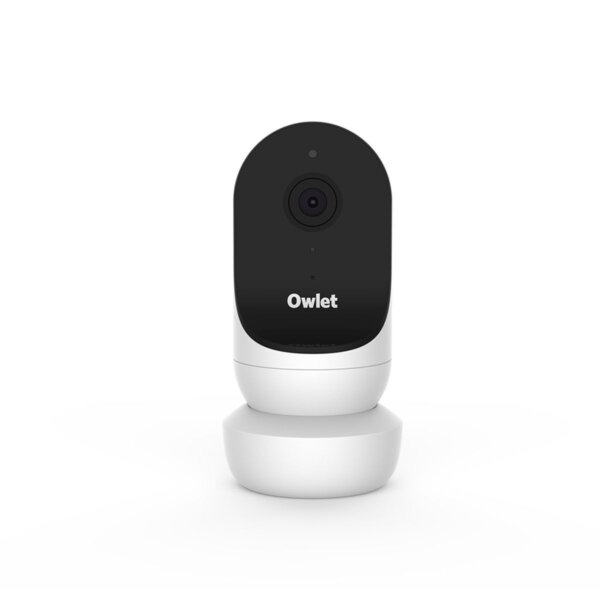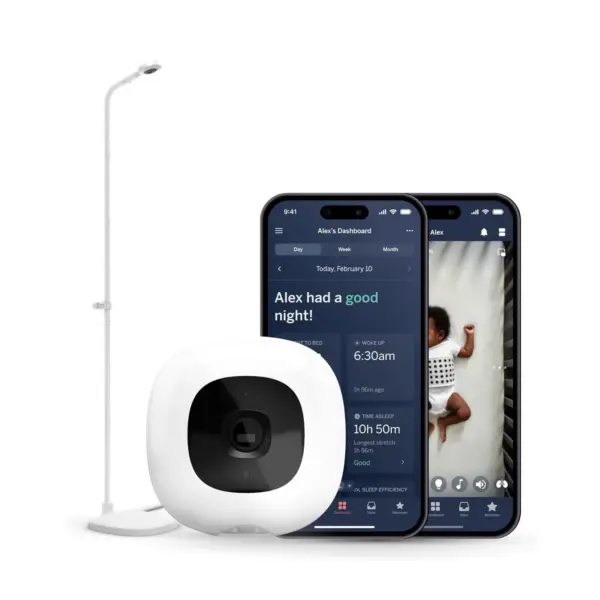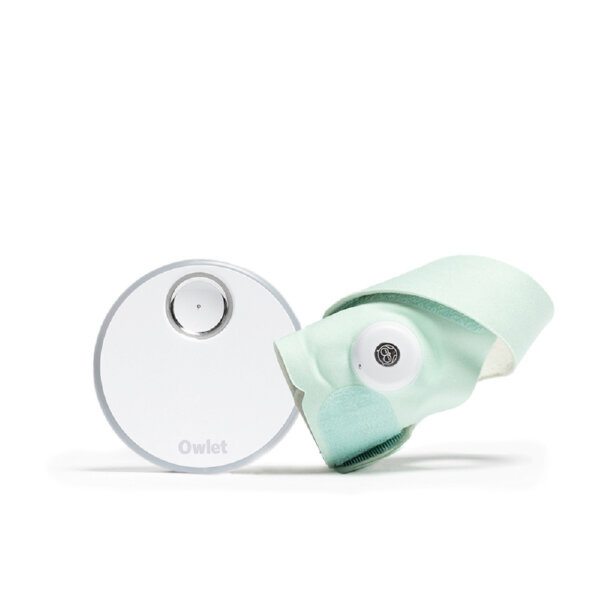
Table of Contents
Surprise — you’ve got double (or triple) trouble coming your way, and we’re so excited for you! You might be thinking, “We’ll just get two of everything”, but when it comes to baby monitors, it’s not always that simple — especially here in our little corner of Africa.
From split-screen setups to breathing monitors, app-only options to fully loaded parent units, the choices can get confusing fast — and to make things trickier, twin-friendly gear isn’t always easy to find locally. But don’t stress — we’re here to break it all down, explain what actually works (and what doesn’t), and help you find the best baby monitor setup for your twin journey. Let’s dive in!
Twin Friendly Breathing & Oxygen Saturation Monitors
Snuza Pico 2
The Snuza Pico 2 is a smart, wearable baby monitor that clips onto your baby’s nappy to track abdominal movement. It also monitors skin temperature, sleep position, and provides sleep analytics via the Snuza Connect app. If no movement is detected after 15 seconds, it vibrates gently to rouse your baby. If movement still doesn’t resume after another 5 seconds, it sounds a loud alarm.
How Does the Snuza Pico 2 Work for Twins?
You can connect up to 4 Snuza Pico 2 devices to a single Snuza Connect app, making it ideal for twins or multiples. Each monitor operates independently, so you can monitor babies in separate cots or rooms without interference.
However, only one phone or tablet can be actively connected to the devices at any one time. This means only one caregiver can have live access to the data at a time — an important factor to consider if multiple caregivers need simultaneous access.
Many parents find the Snuza Pico 2 works best when paired with a separate video monitor, giving them both movement tracking and visual reassurance.
Pros
- Connects up to 4 monitors — ideal for twins or multiples
- Affordable & Medical Aid Approved
- Each unit works independently for separate cots or rooms
- Portable and easy to use, no fixed setup needed
- Tracks breathing, skin temperature, sleep position
- Vibrates to rouse baby — great for premature or at-risk infants
- Flexible and travel-friendly for use anywhere
Cons
- Only one phone or tablet can connect at a time
- No built-in video or audio — may need a separate monitor
- Not suitable for bed sharing or co-sleeping— one baby’s movement can affect the other’s readings
Snuza Hero MD
The Snuza Hero MD is a standalone wearable breathing monitor that clips directly onto your baby’s nappy and tracks abdominal movement. If no motion is detected for 15 seconds, it vibrates gently to rouse the baby. If movement doesn’t resume after another 5 seconds, it sounds a loud alarm to alert caregivers.
Unlike the Pico 2, the Hero MD does not connect to an app or phone, making it a hassle-free, simple-to-use device that works independently — perfect for parents who prefer simple hassel-free solutions.
How Does the Snuza Hero MD Work for Twins?
The Snuza Hero MD operates entirely offline, which means there’s zero connectivity interference, even when using two devices side-by-side. Each unit functions independently and doesn’t rely on Wi-Fi, Bluetooth, or any app. This makes it an excellent choice for twins who are co-bedding, or for parents who want easy, app-free monitoring without managing extra devices.
Pros
- Standalone unit — no app or phone connection required
- Affordable & Medical Aid Approved
- Simple and easy to use
- No risk of interference, even with multiple monitors
- Vibrate-to-rouse and alarm feature for breathing irregularities
- Compact and travel-friendly
Cons
- No smartphone connectivity or data tracking
- No temperature, sleep analytics, or positional tracking
- No built-in video or audio — may need a separate monitor
- Not suitable for bed sharing or co-sleeping — movements from one baby can affect the readings of the other
Hubble Guardian+
The Hubble Guardian is a wearable baby health tracker that monitors heart rate, oxygen levels, skin temperature, and sleep patterns. It includes a base station that functions as a sound monitor, complete with two-way audio and a built-in nightlight.
The device connects to the Hubble app, where parents can view live health data and track sleep trends. Each Guardian must be paired with its own base station to function properly.
How Does the Hubble Guardian Work for Twins?
You can use multiple Hubble Guardians at the same time, with each baby wearing their own device and connecting to the Hubble app. However, since each Guardian requires its own base station — which also acts as a sound monitor — using two in the same room is not ideal, as it can cause overlapping audio or confusion. The system works best when your twins sleep in separate rooms, allowing each unit to function independently.
It’s one of the few systems that works well even if your twins are sharing a cot or co-sleeping, as the sock tracks oxygen saturation directly from the baby, rather than relying on movement detection like many other monitors. This makes it ideal for co-bedding setups.
You can seamlessly add on video monitoring by pairing the Hubble Guardian with a Nursery Pal Cloud or Sky Vision camera. While you’ll be able to view all the information from both the wearable and the camera in the Hubble app, this data won’t appear on the parent unit. For twins, you’ll also need to purchase two video monitors — one for each baby — to ensure full coverage.
Pros
- Monitors heart rate, oxygen levels, skin temperature, and sleep
- Includes a sound monitor with two-way talk and nightlight
- Connects to the Hubble app for real-time tracking
- Supports multiple Guardians in the same app
- Good value for money compared to other oxygen saturation monitors on the market.
- add on video monitoring with teh hubble nursry pal Pro
Cons
- Each Guardian requires its own base station, meaning you’ll need to purchase two monitors if you’re monitoring twins
- Not medical aid approved
- No parent unit — app-based monitoring only
- No built-in video or audio monitoring – must be paired with a separate camera for full coverage
Twin Friendly Breathing & Video Monitors
Angelcare AC25
The Angelcare AC25 is an all-in-one baby monitor that combines movement monitoring, video, and audio. It includes a sensor pad that slips under the mattress to detect subtle breathing movements, and a camera that streams video directly to a dedicated parent unit (no WiFi required — uses secure radiofrequency).
How Does the Angelcare AC25 Work for Twins?
However, only one sensor pad can be connected to a single parent unit, and additional pads or cameras are not sold separately. This means you have two options for monitoring twins:
Buy two full AC25 units — one for each baby, each with its own camera, sensor pad, and parent unit. Angelcare doesn’t officially recommend using two units in the same room due to potential radiofrequency interference, though many parents have reported no issues in real-world use.
Use one AC25 unit with two cameras — monitor both babies visually, but only one baby will have motion/breathing monitoring via the sensor pad. This can be a cost-effective compromise if you’re prioritising video and sound for both, and motion monitoring for just one. However, you will still need to purchase two complete AC25 monitor sets in order to access the second camera, as cameras and sensor pads are not sold separately.
Pros
- Combines movement, video, and audio monitoring in one system
- No WiFi required — uses secure, interference-resistant radiofrequency
- Parent unit supports two cameras for visual monitoring of both babies
- Ideal for twins in separate rooms when using two full sets
- Reliable and trusted brand with a solid local support base
Cons
- Only one sensor pad can connect per parent unit
- To monitor both twins with movement sensors, you’ll need to buy two full units
- Using two units in the same room may cause interference (though often reported to work fine)
- Not Medical Aid approved
Nanit Pro
The Nanit Pro is a smart video baby monitor that tracks breathing motion using its Breathing Wear — a specially designed band, swaddle, or sleep sack that reflects a visual pattern the camera tracks in real-time.
The camera streams high-definition video to the Nanit app, where parents can monitor their baby’s breathing motion, sleep patterns, and growth. It also offers personalised sleep insights, but these advanced features require a subscription after the first 6 months. Basic video streaming and breathing monitoring continue to work without a subscription.
How Does the Nanit Pro Work for Twins?
The Nanit Pro is fully twin-compatible — simply purchase two Nanit Pro monitors, each of which includes a breathing band. Additional swaddles and sleep sacks are available separately.
You can link both cameras to the Nanit app and use the split-screen view to monitor both babies at once, all within the same dashboard. This makes it ideal for twins sleeping in separate cots or rooms.
However, the breathing motion monitoring only works when each baby is in their own cot with their own camera. If twins are sharing a cot, the breathing component will not function accurately, as the system can only track the motion pattern of one baby per camera.
Pros
- Smart video monitor with breathing motion tracking
- Split-screen mode to view both babies at the same time
- Tracks sleep, provides insights, and growth data
- All data is available in one app — streamlined experience for parents
- Works well for separate cots or rooms
- No sensors or wearables attached directly to the baby
Cons
- Pricey – You’ll need two full Nanit Pro units for twin use
- Subscription required after 6 months to access advanced insights and analytics
- No parent unit — app-based monitoring only
- Breathing monitoring relies on visual tracking — may not suit everyone’s comfort level
Owlet Dream Duo
The Owlet Smart Sock tracks your baby’s oxygen saturation, heart rate, and sleep trends, offering valuable health insights through the Owlet Dream App. When paired with the Owlet Cam, it adds HD video, two-way audio, and room temperature monitoring, giving you a comprehensive view of your baby’s wellbeing.
You can choose to purchase the Smart Sock alone or combine it with the camera for a full 360-degree monitoring experience.
How Does the Owlet Smart Sock & Camera Work for Twins?
Owlet is twin-compatible — you can link multiple socks and cameras to the same Owlet Dream App, each labelled for individual babies.
It’s one of the few systems that works well even if your twins are sharing a cot or co-sleeping, as the sock tracks oxygen saturation directly from the baby, rather than relying on movement detection like many other monitors. This makes it ideal for co-bedding setups.
You can also mix and match components to suit your needs — for example, purchase one camera + sock bundle for one twin and just the sock alone for the other. Both can still be monitored from the same app.
Pros
- Monitors oxygen saturation, heart rate, and sleep trends
- Camera provides HD video and two-way talk
- Works well even if twins share a cot or co-sleep
- Multiple socks and cameras can be connected to one app
- No subscription fees
Cons
- Expensive — purchasing two full sets can be costly
- No parent unit — app-based monitoring only
- No split-screen view for live video feeds. You’ll need to toggle between the different camera feeds to view them.
Twin Friendly Video Monitors
BabyWombWorld Video Baby Monitor with 2 Cameras
The BabyWombWorld Baby Monitor is a simple, budget-friendly video monitoring system that includes two cameras connecting to one parent unit via secure radiofrequency — no WiFi or app required.
The 2.4” colour LCD screen displays clear video and audio, while infrared night vision ensures visibility in low light. You can manually tilt or rotate the cameras for the perfect view. The parent unit runs on battery or mains power and features VOX (sound activation) for extended battery life. It also displays the room temperature, supports two-way talkback, and has 8 built-in lullabies for remote soothing.
How Does the BabyWombWorld Baby Monitor Work for Twins?
This monitor comes with two cameras and allows you to switch quickly between views on a single parent unit.
It’s ideal for twins in separate cots or rooms, offering basic, reliable video coverage without the need for internet, apps, or ongoing subscription fees.
Pros
- Includes two cameras with one dedicated parent unit
- No WiFi or app required — works over secure radiofrequency
- Reliable coverage even in large double-story homes
- VOX sound-activation saves battery life
- Two-way talk, room temperature display, night vision, and built-in lullabies
- Affordable and easy to use — great value for money
Cons
- No split-screen — must toggle between camera views
- Cameras must remain plugged in (no internal battery)
- No app or remote access when away from home
- Lower resolution and fewer smart features compared to high-end monitors
Hubble Connected Nursery Pal Cloud
The Hubble Nursery Pal Cloud is a smart HD video monitor that lets you keep an eye on your baby both at home and from anywhere. It comes with a 5” colour parent unit that connects locally via radiofrequency for real-time monitoring, and it also links to the HubbleClub app over Wi-Fi for remote access.
With features like digital pan, tilt, zoom, infrared night vision, two-way talk, room temperature display, and a soothing 7-colour night light, it’s designed to help you monitor and comfort your little one with ease. The built-in sleep trainer and preloaded lullabies, stories, and nature sounds create a calming sleep environment. You can connect up to four cameras and view them in split-screen or toggle between them, making it a great choice for twins or growing families.
How Does the Hubble Connected Nursery Pal Cloud Work for Twins?
The Hubble Connected Nursery Pal Cloud is twin-friendly, allowing you to connect up to four cameras to a single parent unit. You can toggle between views or use split-screen mode to monitor both babies at once—ideal for twins in separate cots or rooms. The system also connects to the HubbleClub app, giving you remote access and additional features like sleep tracking, soothing sounds, and room temperature monitoring.
However, in South Africa, cameras are not sold separately, so you’ll need to purchase two full sets to monitor both babies. While each camera can only be paired with one parent unit at a time, you have the flexibility to either link both cameras to a single parent unit, or use one parent unit per baby. Some parents choose to store the second unit as a backup, while others find it helpful for monitoring twins in different parts of the house. If you’re also using Hubble Guardian wearables, health and video data can be viewed together in the app—though health tracking data is not displayed on the parent unit.
Pros
- Connects locally to the parent unit via secure radio frequency and remotely through Wi-Fi using the HubbleClub app
- Supports up to 4 cameras — ideal for twins or multiples
- Split-screen or toggle viewing on the parent unit and app
- Includes sleep trainer, night light, lullabies, and two-way talk
- No app subscription needed for basic video and monitoring features
- Can pair with Hubble Guardian wearables for combined health + video tracking in the app
Cons
- You’ll need to buy two full monitor sets — cameras aren’t sold separately in South Africa
- Each camera can only be paired with one parent unit at a time, which means the second parent unit you receive is essentially redundant unless you choose to use the monitors completely separately for each baby
- Health tracking from Guardian wearables does not dis
Hubble Connected Nursery Pal Dual Vision
The Nursery Pal Dual Vision is a smart HD baby monitor with both a standard and wide-angle lens, allowing you to view your baby and the nursery at the same time. With AI Motion Tracking, the close-up lens automatically follows your baby to keep them centred in the frame.
It connects locally to the parent unit via radio frequency and remotely via Wi-Fi through the HubbleClub app, giving you live video, alerts, and sleep insights. Additional features include two-way talk, night vision, room temperature display, and a library of lullabies, audiobooks, and nature sounds. The ConnectChat™ button even lets toddlers call a parent’s phone, making it a monitor that grows with your child.
How Does the Hubble Connected Nursery Pal Dual Vision Work for Twins?
The Dual Vision camera provides a wide field of view thanks to its combination of standard and wide-angle lenses, which may allow you to temporarily monitor both twins in the same cot using just one device. However, this setup is not the intended use of the second lens — it’s designed to give a fuller view of the nursery while the close-up lens tracks one baby. That said, with some creative angling, you could potentially position the camera to include a view of your second baby, especially if they’re sleeping nearby.
For proper twin monitoring, the Nursery Pal Dual Vision supports up to four cameras and includes split-screen functionality on the parent unit, making it well-suited for twins in separate cots or rooms. However, since cameras are not sold separately in South Africa, you would need to purchase two complete monitor sets. It’s also worth noting that each camera can only pair with one parent unit at a time, so while you can monitor both cameras from one unit, the second parent unit can’t be used to view both feeds. You can either store it as a backup or use it as a dedicated monitor for one baby in another space.
Pros
- Wide-angle lens can, in some cases, be angled to include both babies in one cot temporarily
- Supports up to 4 cameras with split-screen view — ideal for twins in separate cots or rooms
- Connects both locally (to parent unit) and remotely via Wi-Fi through the HubbleClub app
- Can pair with Hubble Guardian wearables for combined health + video tracking in the app
Cons
- Not specifically designed to monitor two babies from one camera — wide-angle lens may not always provide reliable coverage for both
- To monitor twins effectively, you’ll need to buy two full monitor sets — cameras aren’t sold separately in South Africa
- Each camera can only be paired with one parent unit at a time, which means the second parent unit you receive is essentially redundant unless you choose to use the monitors completely separately for each baby
Hubble Connected Sky Vision-AI Pro Smart Monitor
The Hubble Connected SkyVision AI Pro is an award-winning smart baby monitor, voted The Bump’s Best Baby Monitor of 2024. It’s designed to offer advanced care, safety, and convenience, with AI-powered features like Covered Face Alerts, Sleep Analytics, Baby Eye Wellness Tracking, and the ability to capture Precious Baby Moments.
It includes both a crib mount for newborns and a flexible desk mount for older babies or travel. The monitor features a 7-colour night light, sleep trainer, lullabies and stories, two-way talk, room temperature monitoring, night vision, and full pan, tilt, and zoom controls. With dual connectivity, you can view your baby locally on the 5” touchscreen parent unit or stream remotely via the HubbleClub app. The parent unit also doubles as an entertainment console, with preloaded games and videos — making it a smart solution that grows with your family.
How Does The Hubble Connected Sky Vision-AI Pro Smart Monitor Work for Twins?
The SkyVision AI Pro supports multiple camera connections, so you can monitor twins in separate cots or rooms through the parent unit or Hubble app. The 5” touchscreen allows you to switch between live feeds or use split-screen viewing (depending on model capabilities), and the app lets you track each baby’s activity individually.
However, to monitor twins, you’ll need to purchase two full SkyVision units, as additional cameras are not sold separately in South Africa. Each camera pairs with one parent unit at a time, so you can choose to use a single parent unit for both cameras or assign one unit to each baby for dedicated monitoring. The AI features, such as sleep tracking and face position alerts, are available per camera and work best when each baby has their own device.
Pros
- Connects locally to the parent unit via secure radio frequency and remotely through Wi-Fi using the HubbleClub app
- Supports up to 4 cameras — ideal for twins or multiples
- Split-screen or toggle viewing on the parent unit and app
- Offers advanced AI features including Covered Face Alerts, Sleep Analytics, Baby Eye Wellness Tracker, and positional alerts
- No app subscription needed for basic video and monitoring features
- Can pair with Hubble Guardian wearables for combined health + video tracking in the app
Cons
- To monitor twins and make use of the smart AI features, you’ll need to buy two full monitor sets — cameras aren’t sold separately in South Africa
- Each camera can only be paired with one parent unit at a time, which means the second parent unit you receive is essentially redundant unless you choose to use the monitors completely separately for each baby
TP-Link Tapo Cameras
Tapo cameras are a very budget-friendly option for video monitoring, originally designed for smart home use but commonly used as baby monitors thanks to features like motion and cry detection and two-way talk. While they don’t include extras like a room temperature display, lullabies, or a dedicated parent unit, they’re easy to set up, hassle-free, and can be repurposed later for general home security. They pair especially well with breathing monitors like the Snuza, giving you a 360-degree monitoring solution at a fraction of the cost of high-end baby monitors.
How Does the TP-Link Tapo Cameras Work for Twins?
Tapo supports up to 30 cameras in the app, allowing you to add a camera for each baby. However, the app only lets you view one feed at a time, so it’s not ideal for real-time split-screen monitoring. That said, it’s a great option for twins in separate cots or rooms, especially if paired with wearable monitors for health tracking. This setup offers flexibility and affordability, especially for parents looking to monitor multiple spaces or grow into a smart home system over time.
Pros
- Very budget-friendly and easy to set up
- Includes cry detection and two-way talk
- Can connect up to 30 cameras in the app — ideal for twins or multiples
- Pairs well with breathing monitors like the Snuza for a complete 360° monitoring solution
- Can be repurposed as security cameras for home
Cons
- No baby-specific features like room temperature display, lullabies, or a dedicated parent unit
- No split-screen or multi-camera viewing — you can only view one feed at a time in the app
- Requires a stable internet connection for remote access
- Lacks health or sleep tracking features
The Final Verdict
The verdict, as usual, comes down to what works best for your needs and your budget. Every family’s setup is different — and with twins, the stakes feel twice as high (and let’s be honest, sometimes twice as confusing!).
If you’re looking for breathing monitoring only, the Snuza Hero MD is a winner — simple, reliable, medical aid approved, and no app or Wi-Fi needed. If you’ve got the budget and want a top-of-the-line, all-in-one system, the Owlet or Nanit offer some of the best twin-compatible options on the market. They’re smart, intuitive, and built for parents who want health tracking and video monitoring in one. For a strong, locally available video solution, two Hubble Connected monitors (like the Nursery Pal Cloud or SkyVision AI Pro) give you great features, dual-camera support, and a trusted setup you can grow with. On a budget? A Tapo smart cam setup is surprisingly capable — add one for each baby, pair it with a Snuza, and you’ve got a 360-degree monitoring solution that won’t break the bank and can be repurposed later for home security.
Choosing the right setup can be overwhelming, especially with two on the way — so if you’re expecting twins, we really recommend reaching out via live chat or WhatsApp. Let us know you’re shopping for two, and we’ll help you figure it out together.
Bestselling Twin Friendly Baby Monitors
Our Guidance Pledge
We’re dedicated to providing you with practical, evidence-based information to help you make the best choices for your growing family. All content is medically reviewed by our in-house doctor and/or experts such as OB-GYNs, doulas, and midwives, and is based on the latest international guidelines, peer-reviewed studies, and reputable sources from academic institutions and medical journals. Learn More
